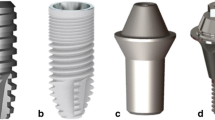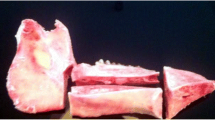Abstract
The aim of this in vitro study was to evaluate the removal torque values on abutments and the morphological wear aspects of two different dental implant joints after immersion in a medium containing biofilm from human saliva. Twenty implant-abutment assemblies were divided into four groups in this study: (A) Morse taper free of medium containing biofilm, and (B) after contact with a medium containing biofilm from human saliva; (C) External Hexagon free of medium containing biofilm, and (D) after contact with medium containing biofilm from human saliva. The abutments were firstly torqued to the implants according to the manufacturer´s recommendations, using a handheld torque meter. Groups B and D were immersed into 24 well-plates containing 2 ml BHI medium with microorganisms for 72 h at 37 °C under microaerophilic conditions. After detorque evaluation, the abutments were removed and the implants were analyzed by scanning electron microscopy (SEM) and profilometry. On the detorque evaluation, the torque values decreased for the external hexagon implants and increased for the Morse taper implants. However, the values were lower when both implant-abutment assemblies were in contact with a medium containing biofilm from human saliva. The wear areas of contacting surfaces of the implants were identified by SEM. The highest average roughness values were recorded on the surfaces free of biofilm. The medium containing biofilm from human saliva affected the maintenance of the torque values on Morse taper and external hexagon abutments. Additionally, the removal of abutment altered the inner implant surfaces resulting in an increase of wear of the titanium-based connection.
Graphical Abstract








Similar content being viewed by others
References
Giglio GD, Abutment selection in implant-supported fixed prosthodontics. Int J Periodontics Restorative Dent. 1999;19(3):233–41.
Hansson S, Implant-Abutment Interface: biomechanical study of flat top versus conical. Clin Implant Dent Relat Res. 2000;2(1):33–41.
Pereira J, Morsch CS, Henriques B, Nascimento RM, Benfatti CAM, Silva FS, López-López J, Souza JCM. Removal torque and biofilm accumulation at two dental implant-abutment joints after fatigue. Intern J Oral Maxillof Impl. 2016;31(4):813.
Prado AM, Pereira J, Henriques B, Benfatti CAM, Magini RS, Silva FS, López-López J, Souza JCM. Biofilm affecting the mechanical integrity of implant-abutment joints. Intern J Prosthod. 2016;29(4):381.
Gratton D, Aquilino S, Stanford C. Micromotion and dynamic fatigue properties of the dental implant–abutment interface. J Prosthet Dent. 2001;85:47–52.
Quek HC, Tan KB, Nicholls JI. Load fatigue performance of four implant-abutment interface designs: effect of torque level and implant system. Int J Oral Maxillofac Implants. 2008;23(2):253–62.
Seetoh YL, Tan KB, Chua EK, Quek HC, Nicholls JI. Load fatigue performance of conical implant-abutment connections. Int J Oral Maxillofac Implants. 2011;26(4):797–806.
Assunção WG, Delben JA, Tabata LF, Barão VAR, Gomes EA, Garcia IR. Preload evaluation of different screws in external hexagon joint. Implant Dent. 2012;21(1):46–50.
Assunção WG, Barão VAR, Delben JA, Gomes ÉA, Garcia IR. Effect of unilateral misfit on preload of retention screws of implant-supported prostheses submitted to mechanical cycling. J Prosthodont Res. 2011;55(1):12–8.
Gil FJ, Herrero-Climent M, Lázaro P, Rios JV, Implant-abutment connections: influence of the design on the microgap and their fatigue and fracture behavior of dental implants, J Mater Sci Mater Med. 2014;25(7):1825–30.
Vianna CDA, Juliana DDS, Delben A, Barão VAR, Ferreira MB, Henrique P, Assunçao WG. Torque stability of different abutment screws submitted to mechanical cycling. Int J Oral Maxillofac Implants. 2013;28:209–14.
Saidin S, Abdul Kadir MR, Sulaiman E, Abu Kasim NH. Effects of different implant-abutment connections on micromotion and stress distribution: prediction of microgap formation. J Dent. 2012;40(6):467–74.
Sahin S, Cehreli MC, Yalçin E. The influence of functional forces on the biomechanics of implant-supported prostheses--a review. J Dent. 2002;30(7–8):271–82.
Duarte ARC, Neto JPS, Souza JCM, Bonachela WC. Detorque evaluation of dental abutment screws after immersion in a fluoridated artificial saliva solution. J Prosthodont. 2013;22(4):275–81.
Zavanelli Ra, Henriques GEP, Ferreira I, Rollo JMDA. Corrosion-fatigue life of commercially pure titanium and Ti-6Al-4V alloys in different storage environments,. J Prosthet Dent. 2000;84(3):4–9.
Souza JCM, Barbosa SL, Ariza E, Celis J-P, Rocha La. Simultaneous degradation by corrosion and wear of titanium in artificial saliva containing fluorides,. Wear. 2012;292–293:82–8.
Souza JCM, Henriques M, Oliveira R, Teughels W, Celis J-P, Rocha La. Biofilms inducing ultra-low friction on titanium. J Dent Res. 2010;89(12):1470–5.
Souza JCM, Henriques M, Oliveira R, Teughels W, Celis J-P, Rocha La. Do oral biofilms influence the wear and corrosion behavior of titanium? Biofouling. 2010;26(4):471–8.
Ricomini Filho AP, Fernandes FSDF, Straioto FG, da Silva WJ, Del Bel Cury AA. Preload loss and bacterial penetration on different implant-abutment connection systems. Braz Dent J. 2010;21(2):123–9.
Landolt D. Electrochemical and materials aspects of tribocorrosion systems,. J Phys D Appl Phys. 2006;39(15):3121–7.
Souza JCM, Mota R, Sordi MB, Passoni BB, Benfatti CAM, Magini RS. Biofilm formation on different materials used in oral rehabilitation. Braz Dent J. 2016;27(2):141–7.
Jorge JRP, Barão VAR, Delben JA, Assunção WG. The Role of implant/abutment system on torque maintenance of retention screws and vertical misfit of implant-supported crowns before and after mechanical cycling. Int J Oral Maxillofac Implants. 2013;28(1):415–421.
Ferreira MB, Delben JA, Barão VAR, Faverani LP, Dos Santos PH, Assunção WG. Evaluation of torque maintenance of abutment and cylinder screws with Morse taper implants. J Craniofac Surg. 2012;23(6):e631–4.
Hoyer SA, Stanford CM, Buranadham S, Fridrich T, Wagner J, Gratton D. Dynamic fatigue properties of the dental implant-abutment interface: joint opening in wide-diameter versus standard-diameter hex-type implants. J Prosthet Dent. 2001;40:599–607.
Cruz HV, Souza JCM, Henriques M, Rocha LA. Tribocorrosion and bio-tribocorrosion in the oral environment: the case of dental Implants. In: Davim JP, editor. Biomedical Tribology. Hauppauge, NY: Nova Science Publishers; 2011. p 1–33.
Souza JCM, Henriques M, Teughels W, Ponthiaux P, Celis J-P, Rocha LA. Wear and corrosion interactions on titanium in oral environment: literature review. J Bio- Tribo Corros. 2015;1:13.
Acknowledgements
The authors are sincerely thankful to the Central Electron Microscopy Laboratory (LCME) at the Federal University of Santa Catarina (UFSC). The authors also aknowledge the finnancial support provided by CNPq (Conselho Nacional de Desenvolvimento Científico e Tecnológico) in the scope of the project PVE/CAPES/CNPq 407035/2013-3 and by FCT (Fundação para a Ciência e Tecnologia - Portugal) on the projects UID/EEA/04436/2013 and EXCL/EMS-TEC/0460/2012.
Author information
Authors and Affiliations
Corresponding author
Ethics declarations
Conflict of interest
This article have no financial affiliation from any medical device company (e.g., employment, direct payment, stock holdings, retainers, consultant ships, patent licensing arrangements or honoraria), or involvement with any commercial organization with direct financial interest in the subject or materials discussed in this manuscript, nor have any such arrangements existed in the past years. Any other potential conflict of interest is disclosed.
Rights and permissions
About this article
Cite this article
Prado, A.M., Pereira, J., Silva, F.S. et al. Wear of Morse taper and external hexagon implant joints after abutment removal. J Mater Sci: Mater Med 28, 65 (2017). https://doi.org/10.1007/s10856-017-5879-6
Received:
Accepted:
Published:
DOI: https://doi.org/10.1007/s10856-017-5879-6




